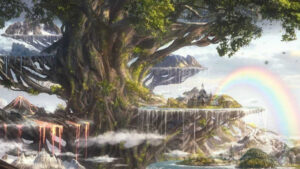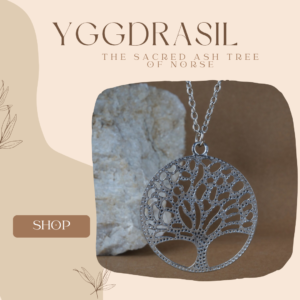In the tapestry of Norse mythology, Yggdrasil stands majestically, its roots delving deep into ancient tales and branches reaching out to touch the essence of human belief. This grand ash tree is not a mere plant but a cosmic entity, binding the universe together.
What is Yggdrasil?
Imagine a time before time, when the universe was a void named Ginnungagap. From this emptiness, Yggdrasil emerged, connecting the nine realms of Norse cosmology. Its branches held Asgard, the realm of gods. Its roots reached into the mysterious depths of Niflheim and Jotunheim, the land of giants. The tree’s vastness was such that its highest bough, Lerad, was home to an eagle, and among its roots lurked the serpent Nidhogg, gnawing ceaselessly.
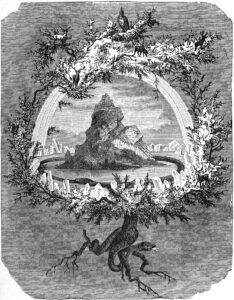
Yggdrasil, often referred to as the World Tree, stands as the axis mundi in Norse cosmology. It’s more than just a tree. It’s a cosmic structure linking the heavens, earth, and underworld.
The Origin Story of Yggdrasil
Mythology narrates that Yggdrasil sprouted at the dawn of time. It grew from the primordial void, connecting the nine worlds of Norse cosmology. This ash tree serves as a shelter and meeting place for gods and creatures alike, from the Aesir to mystical beings.
Various texts have mentioned this evergreen ash tree, notably the well-known Prose Edda and the Poetic Edda. The Poetic Edda, an anthology of anonymous poems, includes material from the Icelandic manuscript Codex Regius, a key source for Norse mythology. Authored by the 13th-century Icelandic historian Snorri Sturluson, the Prose Edda is a compilation of several books. Within these, in the book Gylfaginning, Chapter 15 offers a clear description of Yggdrasil:
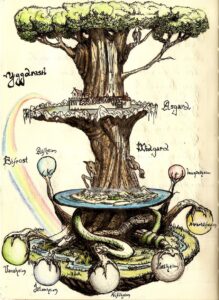
“The ash is of all trees the biggest and the best. Its branches spread out over the world and extend across the sky. Three of the tree’s roots support it and extend very, very far. One is among the Æsir [Asgard], the second among the frost-giants, where Ginnungagap once was. The third extends over Niflheim, and under that root is Hvergelmir, and Nidhogg gnaws the bottom of the root.”
Yggdrasil Meaning
It represents resilience, growth, and the cycle of life and death. As Yggdrasil endures the seasons and even survives Ragnarök, it symbolizes the enduring nature of the cosmos. The Roots of the Norse Tree of Life delve into the depths of the underworld, representing wisdom, memory, and the unknown. They symbolize the foundation of existence and the hidden aspects of life.
Yggdrasil and the Creatures of Myth
Yggdrasil was not just a passive observer in these myths. It played a vital role in various stories, like that of the mischievous god, Loki. Underneath Yggdrasil, Loki orchestrated some of his most cunning plans, including the deceit that led to the death of the beloved god Baldr. This event, tied deeply to Yggdrasil, was a precursor to Ragnarök, the end of the world in Norse lore.
In the Ragnarök story, Yggdrasil faces its greatest challenge. This apocalyptic tale sees the tree surviving the end of the world, symbolizing hope and rebirth in the face of destruction.
The tree was also central to Odin’s quest for wisdom. The Allfather, hung himself from Yggdrasil’s branches, sacrificing himself to himself for nine nights, an ordeal that led to his enlightenment and the discovery of runes. This story highlights Yggdrasil’s role not just as a physical entity but as a symbol of sacrifice, knowledge, and rebirth.
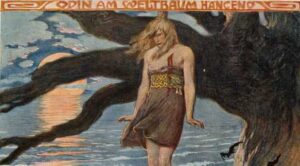
The Image of “Sacred Tree”
Yggdrasil’s concept finds echoes in other mythologies. In Hindu mythology, there is the sacred fig tree, Ashvattha, representing eternal life and a link between the physical and spiritual realms. Similarly, the Bodhi Tree in Buddhism is where Siddhartha Gautama attained enlightenment, becoming the Buddha.
In ancient Mesoamerican cultures, the Ceiba tree was revered as the tree of life, connecting the underworld, the terrestrial realm, and the skies. These trees, like Yggdrasil, were not just plants but symbols of life, wisdom, and connectivity.
This tree is also encountered in stories created by popular culture; for example, remember The Swamp episode in Avatar: The Last Airbender. Actually, no matter how much the narratives change, what is intended to be conveyed is always the same. We are all part of a whole. Is there a better metaphor than a rooted, majestic tree?”
The Yggdrasil Symbol in Modern Life
In today’s context, the Yggdrasil tree stands as a symbol of ecological interconnectedness. It reminds us of our responsibility to nature and the delicate balance of life on Earth.
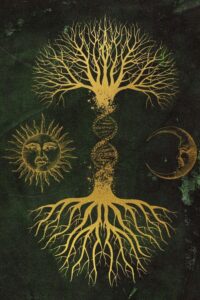
Incorporating the Yggdrasil symbol in daily life can foster a sense of connection to nature and the ancient world. It’s a reminder of resilience, growth, and the interdependence of life. It is a beacon of resilience, growth, and interconnectedness in an increasingly fragmented world. The tree reminds us of our deep connection to nature and each other
Irminsul Yggdrasil: A Saxon Connection
Irminsul Yggdrasil signifies a sacred pillar in Saxon belief, often associated with Yggdrasil. This symbolizes a spiritual axis, mirroring the Norse tree’s role as a cosmic connector and supporter.
The Rune Yggdrasil: Mystical Interpretations
The rune Yggdrasil is not a traditional runic symbol but a modern adaptation, merging the magic of runes with the tree’s imagery. This combination evokes a sense of ancient wisdom and a connection to the Norse spiritual world.
Yggdrasil, more than just a mythical tree, is a bridge between past and present, myth and reality. It encourages us to recognize our connection to the world around us, reminding us of resilience in the face of adversity. This legendary ash tree continues to inspire and influence, a timeless symbol of the interconnectedness of life.

